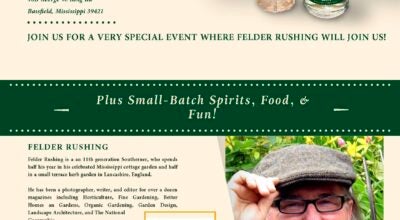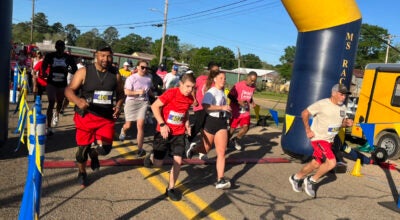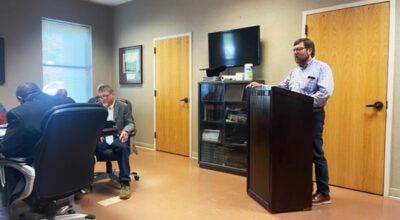Wild hogs becoming a problem in Jeff Davis County?
Published 7:43 pm Wednesday, November 13, 2013

Shirley Burnham / The Prentiss Headlight – Timmy Daughdrill shows some of the smaller hogs he has caught that weigh around 80 lbs. Larger ones have weighed up to 225-250 lbs.
Since Supervisor Bobby Rushing’s brush (literally) with a large wild hog in the Whitesand Community last year there have been various opinions as to whether there is a hog problem in the county. Some state they have never seen a wild hog while deer hunting and feel there is no real problem, but others do not agree. Signs of wild hogs on properties are becoming much more common.
John Wayne Tolar states three were killed on the road in front of his house, and says there is already a big wild hog problem in the Society Hill area possibly because of its proximity to the Pearl River where they find water, mud, forage and solitude plentiful. He plans to do everything possible to eradicate the problem before the swine overrun and destroy his land.
Ray Davis of the Oak Vale area says they make good eating and he has trapped about 20 hogs in the last four-five years but seeing signs of the animals varies, and if you get tough on hunting them they move to another territory only to return later.
Prentiss’ K-9 Officer Timmy Daughdrill, however, is the most serious hog hunter stating in the last year he has probably killed or captured 217 in Jeff Davis County mostly in the south Hwy 13 area.
Daughdrill states there are two kinds of wild hogs in this area: those that descend from tamer varieties that have raised wild called feral hogs and the Russian hogs that are thin, long-nosed, sometimes deep red in color and have a very violent nature. Hogs have about four litters a year of six to twelve and the young start breeding at about six months, so with no natural enemies the county can be overrun in a short period of time.
“Don’t expect to see a hog in the woods,” states Daughdrill. “It will either lie down and hide or run before you see it. If a hog ever stands his ground or comes toward you there is something wrong with it so get away as fast as you can possibly by climbing a tree.”
“Mostly you can tell that hogs are in the area by the mess they leave tearing up the land and their tracks. Tufts of hair on the lower barbed fence strands and mud on trees where they have rubbed and scratched also are obvious signs of a hog problem.”
“You won’t have quail, turkey or deer on your land because their eggs are eaten and their habitat destroyed by these nuisance animals. They tear up pond levees, creek beds roads, hay pastures, deer and garden plots—virtually anything that is planted.”

Shirley Burnham / The Prentiss Headlight – Wild hogs have distinctive features, may be black, brown or red or mixed in color and have the noticeably elongated snout.
With such destructive nature and prolific reproduction, it is no wonder it is always open season on wild hogs in most states.
Daughdrill and his hunting partner Travis Westmoreland use traps and/or dogs to hunt and know it can be dangerous work. When he gets called by a landowner for help to rid their property of a hog problem he and Westmoreland go to work baiting the hog’s familiar areas with the grease they love to rub on their fur, of sour fermented smelling corn (sometimes mixed with whiskey) and peanut butter or a product sold at the Co-op called Hog Wild to lure the smaller hogs into a spring trap. The larger ones are hunted with dogs.
Daughdrill who is a K-9 trainer states he has trained his hog hunting dogs well. His “strike” dogs give voice when they strike up the trail, “bay” dogs run the hog until he is exhausted and turns to face them and “catch dogs” which are the biggest and heaviest, literally hold the animal in their jaws until it can be hobbled and tied.
Daughdrill says hunting hogs is no spur of the moment venture but takes planning and lots of equipment. He wears heavy leather chaps and heavy clothing to keep briars and hogs from getting to his skin and his dogs wear special collars and jackets to keep the razor sharp tusks from injuring them.
“These are smart animals,” states Daughdrill. “If a hog gets hemmed up it will turn ferociously and can seriously injure the dogs or the hunters.”
Wild hog meat is tasty and less fatty than domestic pork and is sold in the market at such businesses as Cabella’s for a handsome price. Daughdrill never kills a hog unless he has somewhere for the meat to go. He feeds out those he catches and will sell to anyone who wants to have it processed into pork chops and other cuts of meat.
Daughdrill is a man who does not turkey, deer or squirrel hunt, but hog hunting is his passion, so if you think you need help with a wild hog problem he may be the one to call. He states he enjoys the excitement and fast pace of the hunt and says, “The action starts when the tailgate drops.”





